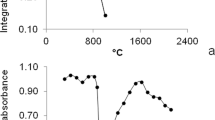Abstract
The amount of sample that is available for analysis in laboratory plant cultivation experiments is usually very limited. Highly sensitive analytical techniques are therefore required, even for elements that are present in the plants at mg g−1 concentrations, and graphite furnace atomic absorption spectrometry (GFAAS) was chosen in this work because of its micro-sampling capability, and its relatively simple operation. Four micro-methods were investigated for the determination of iron in roots and leaves of rice plants: i) a micro-digestion with nitric and hydrochloric acids, ii) a slurry procedure using tetramethylammonium hydroxide (TMAH) tissue solubilizer, iii) a slurry prepared in 1.4 mol L−1 nitric acid, and treated in an ultrasonic bath, and iv) the direct analysis of solid samples. The micro-digestion was suffering from high blank values and contamination problems, so that it could not be recommended for routine purposes. The TMAH method exhibited poor precision and occasional low recoveries, particularly for real samples. Direct solid sampling analysis gave results similar to those obtained with the slurry technique with ultrasonic agitation for the determination of iron in certified reference materials with iron content up to about 100 μg g−1, but was too sensitive for the investigated rice plants, which had an iron content up to several mg g−1. The slurry technique with ultrasonic treatment of the samples, suspended in dilute nitric acid, was finally adopted as the method of choice.
The method was then applied for the determination of iron in the leaves and in different compartments of the roots of two rice cultivars, one sensitive to iron toxicity, an important nutritional disorder, and the other one resistant to iron toxicity. The results suggest that the higher resistance to iron toxicity of the second cultivar is due to a smaller uptake of iron from the soil, resulting in lower iron levels in all compartments of the plant.






Similar content being viewed by others
References
Bienfait HF (1989) Acta Bot Neerl 38:105–129
Sahrawat KL, Mulbah CK Diatta S, Delaune RD, Patrick WH Jr, Singh BN, Jones BN (1996) J Agricult Sci 126:143–149
Anuário Estatístico do Brasil (1996) Instituto Brasileiro de Geografia e Estatística:3–52
Yoshida S (1981) Fundamentals of rice crop science. International Rice Research Institute, Manila, Philippines.
Tanaka A, Loe R, Navasero SA (1966) Soil Sci Plant Nutrition 12:158–164
Drew MC in Tinker B, Läuchli A (1988) Advances in plant nutrition, vol 3. Praeger, New York, pp 115–159
Yamauchi M, Peng XX (1995) Plant Soil 173:21–28
Taylor GJ, Crowder AA, Rodden, R (1984) Amer J Bot 71:666–675
Laan P, Smolders A, Blom CWPM, Armstrong W (1989) Acta Bot Neerl 38:131–145
Mandaji M (2001) Mecanismos de resistência àtoxidez por excesso de ferro em arroz:ênfase no mecanismo de exclusão. Master thesis in cellular and molecular biology, UFRGS, Porto Alegre, Brazil
Sakao S, Uchida H, Fudakawa N, Kubota M (1994) Buzenki Kagaku 43:1101–1105
Welz B, Sperling M (1999) Atomic absorption spectrometry. Wiley VCH, Weinheim
Nascentes CC, Korn MG, Arruda MAZ (2001) Microchem J 69:37–43
Wieteska E, Zioex A, Drzewinnska A (1996) Anal Chim Acta 330:251–257
Viñas P, Campillo N, López García I, Hernández Córdoba M (1993) Food Chem 46:307–311
Suslick KS, Hammerton DA, Cline RE Jr (1986) J Am Chem Soc 108:5641–5642
Ashley K, Andreus RN, Cavajos L, Demange M (2001) J Anal At Spectrom 16:1147–1153
Steven BJ (1983) At Spectrosc 4:176–180
Pozebon D, Dressler LV, Curtius AJ (1998) J Anal At Spectrom 13:1101–1105
Kurfürst U (1998) General aspects of the graphite furnace solid sampling method. In: Kurfürst U (ed) Solid sample analysis, Springer, Berlin Heidelberg New York, pp 21–127
Price WJ, Dymott TC, Whiteside PJ (1980) Spectrochim Acta Part B 35:3–10
Chakrabarti CL, Wan CC, Li WC (1980) Spectrochim Acta Part B 35:93–105
Chakrabarti CL, Wan CC, Li WC (1980) Spectrochim Acta Part B 35:547–560
Muñoz FE, Calvo A, Léon LE (1983) Anal Lett 16:835–846
Belarra MA, Martínez-Garbayo MP, Anzano JM, Castillo JR (1996) Anal Sci 12:483–488
Nowka R, Müller H (1997) Fresenius J Anal Chem 359:132–137
Nowka R, Marr IL, Ansari TM, Müller H (1999) Fresenius J Anal Chem 364:533–540
Bienfait HF, Briel W, Mesland-Mul N (1985) Plant Physiol 78:596–600
Yoshida S, Forno DA, Cook JH, Gomez KA (1976) Laboratory manual for physiological studies of rice. International Rice Research Institute, Manila, Philippines
Lavilla I, Capelo JL, Bendicho C (1999) Fresenius J Anal Chem 363:283–288
Amoedo L, Capelo JL, Lavilla I, Bendicho C (1999) J Anal At Spectrom 14:1221–1226
Lima ÉC, Barbosa F, Krug FJ, Silva MM, Vale MGR (2000) J Anal At Spectrom 15:995–1000
Filgueiras AV, Capelo JL, Lavilla I, Bendicho C (2000) Talanta 53:433–441
Vaisanen A, Suontamo R (2002) J Anal At Spectrom 17:739–742
Yebra MC, Moreno-Cid A (2002) J Anal At Spectrom 17:1425–1428
Slavin W, Manning DC, Carnrick GR (1981) At Spectrosc 2:137–145
Maia SM, Welz B, Ganzarolli E, Curtius AJ (2002) Spectrochim Acta Part B 57:473–484
Tanaka A, Loe R, Navasero SA (1966) Soil Sci Plant Nutri 12:158–164
Acknowledgement
The authors are grateful to Fundação de Amparo a Pesquisa do Rio Grande do Sul (FAPERGS) and Conselho Nacional de Desenvolvimento Científico e Tecnológico (CNPq) for financial support of this work (MMS and JPF) and for research scholarships (ICFD, MM, JPF, and BW), to Instituto Rio Grandense do Arroz (IGRA) for providing the rice seeds, and to Analytik Jena AG for the loan of an atomic absorption spectrometer.
Author information
Authors and Affiliations
Corresponding author
Rights and permissions
About this article
Cite this article
Silva, M.M., Vale, M.G.R., Damin, I.C.F. et al. Method development for the determination of iron in milligram amounts of rice plants (Oryza sativa L.) from cultivation experiments using graphite furnace atomic absorption spectrometry. Anal Bioanal Chem 377, 165–172 (2003). https://doi.org/10.1007/s00216-003-2072-1
Received:
Accepted:
Published:
Issue Date:
DOI: https://doi.org/10.1007/s00216-003-2072-1




